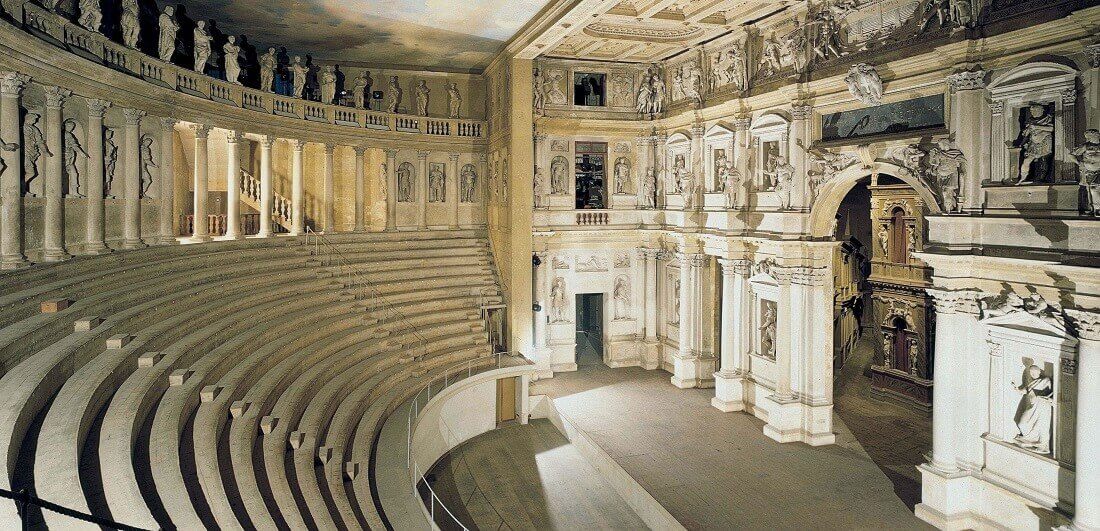
Palladio: the Renaissance architect known all over the world
Andrea Palladio was an Italian architect of the Renaissance, known all over the world. His real name was Andrea di Pietro della Gondola. He has received the qualification of citizen and official architect of the Serenissima and he designed villas, palaces, basilicas and monuments especially in Veneto. UNESCO recognised 24 villas and 23 palaces in Vicenza, place where he was formed and lived most of his life, as World Heritage Site.
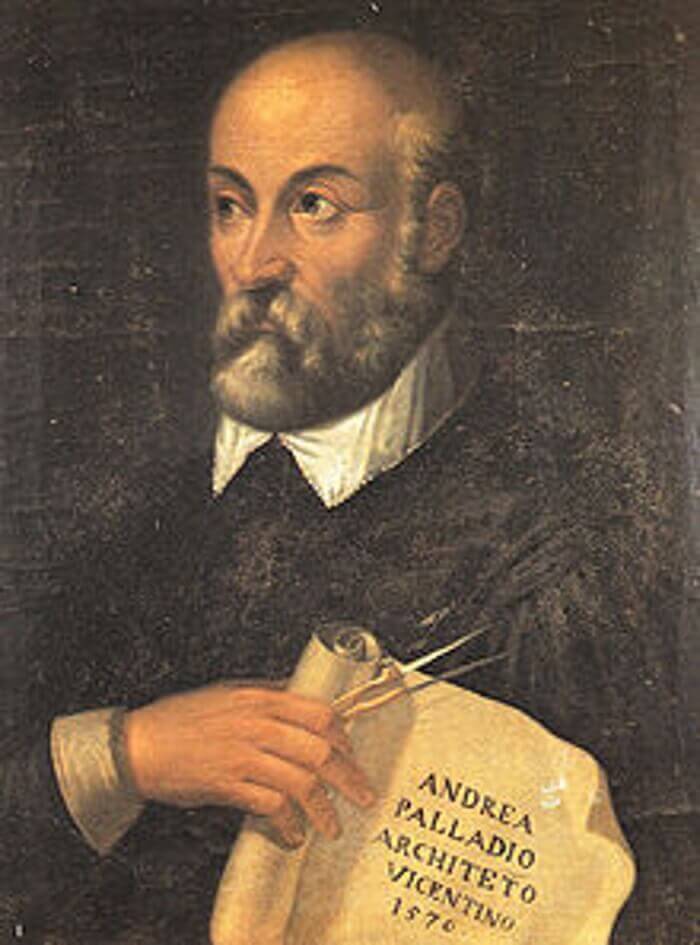
Andrea Palladio portrait – G. B. Maganza work
Palladio and the good fortune to move to Vicenza
Palladio was born in Padua in 1508, from a family of humble origins and died in Maser in 1580 in modest economic conditions. At the age of thirteen he began to work as a stonemason apprentice at Bartolomeo Cavazza’s workshop and to study the classical art and figurative culture of great artists.
In 1523 he moved to Vicenza and started working in the renowned workshop of the builder Giovanni di Giacomo da Porlezza and the sculptor Girolamo Pittoni. Between 1535 and 1538 he met the noble Gian Giorgio Trissino with the Golden Fleece.
Trissino was a cultured writer and a prestigious diplomat, he was very important in the Renaissance culture and well integrated into the aristocracy. During the renovation of his villa, he met Andrea di Pietro among the workers employed on the construction site and, after noticing his talent, decided to take care of his cultural training. He took him to Rome for the study and observation of the beauty of classical architecture.Inspired by Pallas, the goddess of wisdom, and a character from the poem he was writing, he gave him the refined nickname of “Palladio”.

Villa Trissino in Cricoli, where the fateful meeting of Trissino with Andrea Palladio took place
In 1540 a golden age began and Vicenza became a centre of primary importance under the Venetian government. The Venetian aristocracy reorganises the city and its countrysides and Andrea di Pietro della Gondola was asked to design the new residences for the nobles. The city is adorned with beautiful private and public buildings and in the countrysides extraordinary villas are designed.
From 1550, after the death of Trissino, Palladio began to collaborate with Daniele Barbaro, a great scholar of ancient architecture and Patriarch of Aquileia. Barbaro soon became his mentor and, belonging to one of the most important Venetian patrician families, helped him to find clients in other cities.

Palladio statue in Vicenza
Palladian Villas and famous palaces
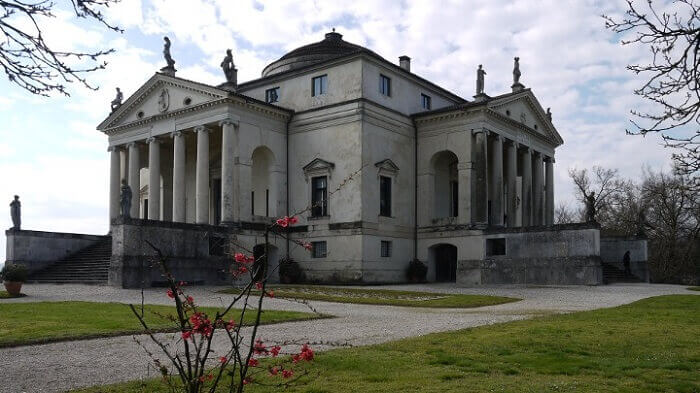
Villa Capra – La Rotonda, Palladio work
Palladio’s reputation, even after his death, was based on his ability to draw and design villas, the so-called “Palladian Villas”. They are the proof of his artistic genius. In addition to being land-owned centers, they had to represent a place of health, well-being, study and reflection.
Palladio has also designed many palaces, two in particular are very important and suggestive:
- the Palladian Basilica is par excellence the artistic symbol of the city of Vicenza recognized as a National Monument. Palladio designed the famous loggia in white marble with serliane modules for the medieval Palazzo della Ragione, built in Gothic style in the mid-fifteenth century. The term basilica is inspired by ancient Rome when it was used to indicate the rectangular public buildings intended for business meetings or the administration of justice. Today it hosts architecture and art exhibitions;
- the Olympic Theatre is the oldest indoor stable theatre in the world with sumptuous interiors created with poor materials. It is inspired by the classic style and has famous scenes designed by the famous architect and scenographer Vincenzo Scamozzi. It was inaugurated in 1585.
Palladio becomes famous for the use of the White Stone
The White Stone of Vicenza is a clear and tender stone extracted from the mountains of Vicenza, in particular the Berici hills, Valdichiana and the Asiago plateau.
Palladio studied it at length, becoming a deep connoisseur. He used it for the bases, the columns, the capitals, the architraves, the decorations and the staircases; the ease of manufacturing and the large quantity available allowed him to ensure a majestic appearance to the residences while saving money to the noble clients. In general, he was a skilled master in using poor materials such as plastered bricks, plaster and wood to achieve monumental effects.
Palladio wrote “The Four Books of Architecture”

I quattro libri dell’architettura – Palladio work
“The Four Books of Architecture” are a famous treatise in four tomes published in Venice in 1570; a precious work of art that influenced the later architecture. Each book deals with different topics and contains information on materials, construction techniques of buildings, streets, bridges and squares made by the Greeks and Latins, hand-drawn tables depicting the architectural orders and reliefs of ancient Roman buildings.
There are handmade drawings and architectural projects of patrician villas and public buildings, some made while he was alive, others completed many years later. He believed that the size of a public building or a villa, its building and stylistic elements, could be obtained from the tables published in the treatise, in accordance with formal and proportional rules.
In the draft of the books and his projects he was inspired by the works of Marco Vitruvio Pollione, a Roman architect active in the second half of the 1st century BC, considered the most famous theorist of architecture.
Palladio legacy is a world heritage
The Palladianism
Palladio has innovated the purity and simplicity of classical architecture, building works in harmony with man and nature. He became master of proportion, light and material. Through the study of classical Greek-Roman antiquity and the reliefs of the magnificent ruins, he reinvented a new style, forever changing the history of architecture, especially the Western one. His ideals of symmetry, order, perfection and elegance have merged into a real style: the Palladianism. This movement, both stylistic and cultural, developed until the 18th century and gradually spread first to Europe and then to the rest of the world. Fortunately, the needs of his time have remained the needs of the modern world, so intuitions and architectural solutions are still appropriate today.
Palladio conquers America
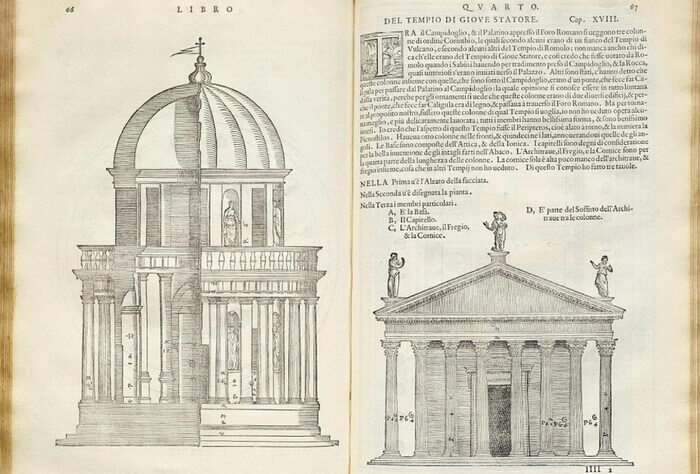
Drawing of I quattro libri dell’architettura – Palladio work
By the end of the 18th century, Palladianism was already widespread in North America. In 2010 the United States Congress declared Palladio “Father of American Architecture” as “The Four Books of Architecture” have constituted a primary source of classical design for many architects and builders in the United States. The Wall Street Stock Exchange in New York, the White House and Congress in Washington were built according to his models. In his honor, the unique national architectural award called “Palladio Award” for creative interpretation and excellence in classical and traditional design, was established.
In 2019, Arte 2000 was the first Italian company to receive the “Palladio Award” for craft, thanks to the project of the “Beaux-Arts” villa in Atlanta in the United States.
International Center for Architecture Studies Andrea Palladio – Palladio Museum

Palladio Museum
The International Center for Architecture Studies Andrea Palladio is a research institute dedicated to the history of architecture for academics from all over the world. It promotes research, publishes books and organizes exhibitions, courses and seminars on both ancient and modern architecture. It was founded in Vicenza in 1958 thanks to the contribution of public authorities and great academics of the time in order to safeguard the Palladian culture and the architectural heritage of Vicenza and Veneto, devastated by the wars. It is located in the Palazzo Barbarano, designed by Palladio, together with the Palladio Museum.
This article contains general information. For questions and curiosities leave a comment below. If you wish to be contacted, please fill out the form.
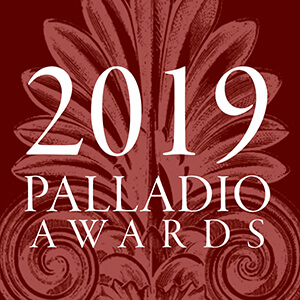
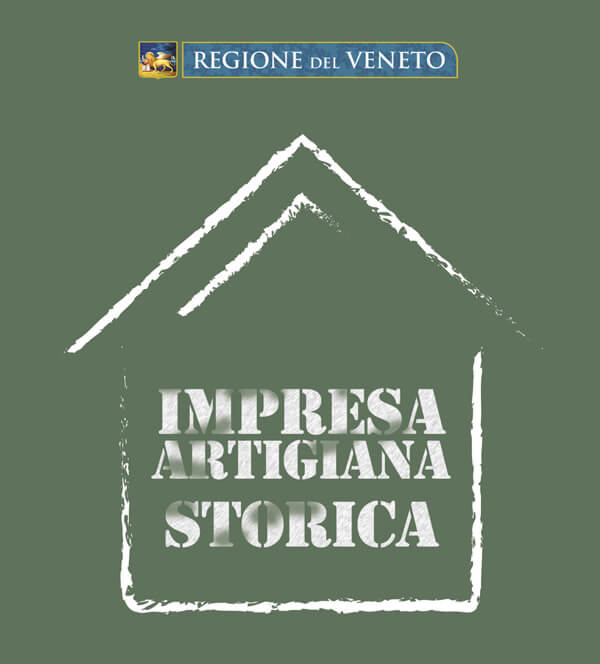

Mohamed
7 April 2022 at 23:25Very very good . And thank you.
Arte 2000 - Paola
8 April 2022 at 10:16I thank you very much for your appreciation, your opinion is very important for me!